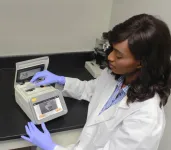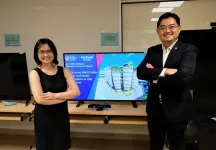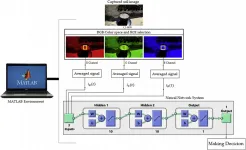Lemurs can sniff out hidden fruit from afar
Lemurs use olfactory cues carried by the wind to locate cantaloupe hidden in the forest
2021-03-15
(Press-News.org) Lemurs can use their sense of smell to locate fruit hidden more than 50 feet away in the forest--but only when the wind blows the fruit's aroma toward them, according to a study published in the American Journal of Physical Anthropology.
"This is the first time research has demonstrated that primates can track a distant smell carried by the wind," said anthropologist Elena Cunningham, a clinical associate professor of molecular pathobiology at NYU College of Dentistry and the study's lead author.
Many animals use their sense of smell to locate food. However, less is known about whether primates can smell food that is far away, or if they instead rely on visual cues or memory to find their next meal.
Because many primates--including ring-tailed lemurs, whose diet is a mix of fruit and leaves--live in forests where their visibility is limited by the trees and foliage, being able to smell and locate distant fruit would be useful for foraging.
The researchers tested whether a group of ring?tailed lemurs living in the Lemur Conservation Foundation in Florida could detect hidden fruit from afar using their sense of smell alone. They hid containers in the underbrush of the forest--some containing ripe cantaloupe and some with fake cantaloupe--at a distance (between 13 and 56 feet) from a path routinely used by the lemurs. The containers were not visible from the path, so the lemurs had to use their sense of smell to locate the cantaloupe.
Smells are carried by the wind in "odor plumes," which animals navigate by monitoring the strength of a smell as they move. They sniff the air at one location, then move and sniff the air again, to see if they are getting closer to the smell in question.
The lemurs were able to find the cantaloupe when the wind blew the aroma of the fruit toward them. Upon detecting the scent of fruit, the lemurs sniffed the air at one or more locations as they moved toward the fruit. Sometimes, after detecting the smell, the lemurs would return to spots where cantaloupe had previously been hidden before going through the process of tracking the odor plume, suggesting that olfactory cues may trigger memories of past meals.
While the containers of fruit hidden at a farther distance took the lemurs longer to locate, they still were able to find cantaloupe hidden as far away as 56 feet off the path. The lemurs did not find the containers of fake cantaloupe.
"The lemurs were able to detect the smell of the cantaloupe among the complex smells of the forest and successfully navigate the odor plume to the fruit," said Cunningham. "The results indicate that olfaction may be used to respond to cues from distant sources. The ability to sniff out distant foods may be a critical foraging skill for lemurs and other primates."
INFORMATION:
Additional study authors include Malvin Janal of NYU College of Dentistry, Devin Edmonds of the Lemur Conservation Foundation and University of Illinois at Urbana-Champaign, and Laura Stalter of the Lemur Conservation Foundation and University of Vermont. The research was funded by NYU College of Dentistry Academy of Distinguished Educators and the New York University Research Challenge Fund Program.
About NYU College of Dentistry
Founded in 1865, New York University College of Dentistry (NYU Dentistry) is the third oldest and the largest dental school in the US, educating nearly 10 percent of all dentists. NYU Dentistry has a significant global reach with a highly diverse student body. Visit http://dental.nyu.edu for more.
ELSE PRESS RELEASES FROM THIS DATE:
2021-03-15
CORVALLIS, Ore. - Oregon State University researchers analyzed more than 17,000 public comments focused on orca conservation in the state of Washington and found that the most common emotional sentiments were trust, anticipation and fear.
The recently published findings have important implications because they provide conservation managers a way to convert a large volume of information to a manageable amount that can help them understand why people might support or reject management actions, the researchers said.
"Emotions are intertwined in our decision-making, often playing a substantive role in public evaluations of conservation policies," said Kelly Biedenweg, an author ...
2021-03-15
(Portland - March 15) Results of a clinical study conducted by researchers in Manaus, Brazil, show that the Gazelle® Malaria test outperformed Rapid Diagnostic Tests (RDTs) and was nearly as accurate as more expensive and time-consuming expert microscopy in detecting Plasmodium vivax (P. vivax) malaria. The data was published Friday, March 12 in the Malaria Journal.
The double-blind study was based on 300 participants who sought care from Fundac?a?o de Medicina Tropical Doutor Heitor Vieira Dourado (FMT-HVD), located in Manaus, an area in the Western Brazilian Amazon, heavily endemic for P. vivax.
"Because P. vivax is not adequately detected by current tests, the infection is frequently missed, and patients don't receive essential treatment," said ...
2021-03-15
Copper nanomaterials with a cubic shape so perfect that they form neatly aligned stacks when brought together have been created by researchers at KAUST. The cuboid copper nanoclusters, developed by rational design, are a new member of an exotic nanomaterial family that has shown many promising properties but has remained very hard to make.
"Copper nanomaterials are a class of materials that exhibit useful properties for the fields of photoluminescence and catalysis," says Ren-Wu Huang, a postdoc in Osman Bakr's lab, who led the research. There is great interest in synthesizing new copper nanomaterials to understand how their structure influences their function.
Copper nanoclusters, which are of an atomically precise structure, are among the few copper nanomaterials that ...
2021-03-15
An interdisciplinary, multinational research team presents a new class of chemical compounds that can be reversibly oxidized and reduced. The compounds known as 'pyrazinacenes' are simple, stable compounds that consist of a series of connected nitrogen-containing carbon rings. They are suitable for applications in electrochemistry or synthesis, as the researchers describe in the science journal Communications Chemistry.
Redox reactions play an important role in our everyday life. In these reactions, one compound releases electrons and is oxidized, while another accepts ...
2021-03-15
A discovery by University of Queensland pain researchers may allow some future cancer patients, including children with leukaemia, to avoid their chemotherapy's worst and most debilitating side effects.
Professor Irina Vetter and Dr Hana Starobova thought "turning off" the inflammation that is one of the body's natural reactions to the chemotherapy drug vincristine might reduce its accompanying pain and unpleasant symptoms.
"We found the anti-inflammatory drug anakinra substantially reduced the awful nerve symptoms for which vincristine chemotherapy is known," Professor ...
2021-03-15
A study by a research team from Nanyang Technological University, Singapore (NTU Singapore) and China's first digital-only bank WeBank has found that security, service quality and system quality are the most important factors for customers who use mobile banking.
Two in five respondents (40%) said that the security they felt while carrying out transactions on mobile applications was their most important consideration.
This was followed by the level of service quality (25%), which referred to whether the banking applications could fulfil users' needs, such as carrying out transactions and easy access to credit card services.
System quality, which considers the performance of the application, including ...
2021-03-15
Researchers at UniSA have developed a cost-effective new technique to monitor soil moisture using a standard digital camera and machine learning technology.
The United Nations predicts that by 2050 many areas of the planet may not have enough fresh water to meet the demands of agriculture if we continue our current patterns of use.
One solution to this global dilemma is the development of more efficient irrigation, central to which is precision monitoring of soil moisture, allowing sensors to guide 'smart' irrigation systems to ensure water is applied at the optimum time and rate.
Current methods for sensing soil moisture are problematic - buried sensors are susceptible to ...
2021-03-15
Dr Daniel Montesinos is a Senior Research Fellow at the Australian Tropical Herbarium, at James Cook University in Cairns. He is studying weeds to better understand (among other things) how they might respond to climate change.
He said most invasive plants are characterised by their rapid pace when it comes to taking up nutrients, growing, and reproducing - and they're even faster in the regions they invade.
"New experiments comparing populations from distant regions show a clear trend for already-fast invasive plants to rapidly adapt even faster traits in their non-native regions," Dr Montesinos said.
This is further pronounced in the tropics and sub-tropics.
"Even though invasives' growth rates are already among the highest for plants, when they invade new territory ...
2021-03-15
A new concept of on-demand drug delivery system has emerged in which the drugs are automatically released from in vivo medical devices simply by shining light on the skin.
A research team led by Professor Sei Kwang Hahn of the Department of Materials Science and Engineering and Professor Kilwon Cho of the Department of Chemical Engineering at POSTECH have together developed an on-demand drug delivery system (DDS) using an organic photovoltaic cell coated with upconversion nanoparticles. This newly developed DDS allows nanoparticles to convert skin-penetrating near-infrared (NIR) light into visible light so that drug release can be controlled in medical ...
2021-03-15
An international team of researchers, affiliated with UNIST has unveiled a novel technology that could improve the learning ability of artificial neural networks (ANNs).
Professor Hongsik Jeong and his research team in the Department of Materials Science and Engineering at UNIST, in collaboration with researchers from Tsinghua University in China, proposed a new learning method to improve the learning ability of ANN chips by challenging its instability.
Artificial neural network chips are capable of mimicking the structural, functional and biological features of human neural networks, and thus have been considered the technology of the future. In this study, the research team demonstrated the effectiveness of the proposed learning method ...
LAST 30 PRESS RELEASES:
[Press-News.org] Lemurs can sniff out hidden fruit from afar
Lemurs use olfactory cues carried by the wind to locate cantaloupe hidden in the forest





